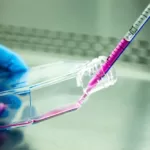History
Phase contrast microscopy is a contrast enhancing optical technique that can be used to create high-contrast images of transparent specimens like living cells (typically in culture), microorganisms, thin tissue slices, lithographic patterns, and fibers. It was first introduced in 1934 by Dutch physicist Frits Zernike.
Define phase contrast microscopy.
Phase-contrast microscopy (PCM) is an optical microscopy technique that transforms phase shifts in light flowing through a transparent object to brightness variations in the picture. While phase shifts are invisible in and of themselves, brightness differences make them noticeable. When light waves pass through a substance other than a vacuum, interaction with the substance changes the wave’s amplitude and phase in a way that depends on the substance’s characteristics.
The scattering and absorption of light, which is frequently wavelength dependent and may produce colors, cause changes in amplitude (brightness). The human eye and photographic equipment are only sensitive to amplitude fluctuations. Phase alterations are consequently undetectable and absent in particular circumstances. However, phase transitions frequently reveal crucial information.
Phase contrast microscopy components
An annular phase plate and annular diaphragm are added to a specifically constructed light microscope‘s fundamental components for phase-contrast microscopy.
The diaphragm Annulus:
- It can be found beneath the condenser.
- It consists of a round disc with an annular groove around it.
- The circular groove allows the light rays to pass through.
- The study object or specimen receives the light rays through the annular groove of the annular diaphragm.
- A picture develops at the objective’s back focal plane.
- At this back focal plane, the annular phase plate is positioned.
The phasing plate:
- Either a positive phase plate with a thin circular groove or a negative phase plate with a thick circular area is involved.
- The conjugate area refers to this portion of the phase plate that may be thick or thin.
- A translucent disc serves as the phase plate.
- In this microscope, the phase contrast is produced with the aid of the phase plate and annular diaphragm.
- This is obtained by distinguishing the straight from the diffracted photons,
- While diffracted light rays travel through the area outside the groove, direct light rays pass through the annular groove.
- The item to be investigated displays a variable level of contrast in this microscope depending on the distinct refractive indices of the various cell components.
Principle of phase contrast microscopy
Living cells that are not stained virtually do not absorb light. Poor light absorption causes incredibly small variations in the image’s intensity distribution. As a result, under a brightfield microscope, the cells are only weak or completely visible. Small phase shifts that are not visible to the human eye happen when light passes through cells. These phase shifts are transformed into amplitude changes in a phase contrast microscope, which are visible as variations in image contrast.
This label-free method, however, is very reliant on the components of the optical pathway being correctly aligned. Weak phase contrast can result from the meniscus effect, which is a naturally occurring phenomenon, disrupting this alignment.

How does phase contrast microscopy works?
Phase contrast microscopy converts small amplitude (brightness) into small phase, which is subsequently perceived as variations in picture contrast.
Phase objects are clear specimens that don’t absorb light. This is because they somewhat alter the phase of light that is diffracted by them; the light is typically phase-shifted relative to the background light by around 14 wavelengths.
Since our eyes can only distinguish variations in light frequency and intensity, they are unable to distinguish these minute phase differences. By boosting the light phase difference, phase contrast makes it possible to create images with high contrast. This property makes it possible to distinguish between background light and specimen-diffracted light.
By reducing (or advancing) the background light by a quarter wavelength and adding a phase plate just before the image plane, the difference in the light phase is increased. Diffracted and background light generate destructive (or constructive) interference when light is focused on an image plane, which reduces (or increases) the brightness of the areas that contain the sample relative to the background light.
The substage condenser’s condenser annulus is the final stop before the tungsten-halogen lamp’s light reaches the specimen. Consequently, parallel light that has been defocused can be employed to illuminate the specimen.
The specimen will not cause all of the light to be diffracted. These light waves create a vivid image on the objective’s rear aperture. The specimen’s ability to diffract light causes it to pass through the diffracted plane and only focus on the image plane. This makes it possible to distinguish between background light and diffracted light.
The background light’s speed is then altered by a quarter wavelength by the phase plate. When the light is focused onto the image plane, the background and diffracted light will interfere negatively or positively, changing the brightness of the areas where the sample is present relative to the background light. A grey filter ring frequently also dims the background by 60 to 90%.
What is the resolution of phase contrast microscopy?
Phase contrast imaging, which can achieve resolutions of less than one angstrom, is the highest-resolution imaging technology ever created. As a result, it makes it possible to see atom columns up close in crystalline materials.
Applications of phase contrast microscopy
- In biological light microscopy, phase contrast is by far the most often employed technique.
- It is a well-known microscopy technique for visualizing live cells in cell culture.
- Living cells can be seen in their natural condition without fixation or labeling when employing this low cost method.
Advantages and disadvantages of phase contrast microscopy
Advantages of phase contrast microscopy
- Without prior fixation or labeling, living cells can be seen in their natural state.
- It increases the visibility of a highly transparent object.
- To study an object under a phase-contrast microscope, no special fixation, staining, or other preparation is required, which saves a lot of time.
- The high-resolution solution examination of intracellular components of living cells, such as the dynamic movement of mitochondria, mitotic chromosomes, and vacuoles.
- It made it possible for biologists to research living cells and how cell divide.
- If the specialized phase objectives meet the tube length requirements and the condenser will accept an annular phase ring of the right size, phase contrast optical components can be added to almost any brightfield microscope.
Disadvantages of phase contrast microscopy
- The outline of details with a large phase shift frequently has halos surrounding it in phase contrast photographs. These haloes are artifacts that can obscure the edges of details.
- Phase annuli that restrict the system’s numerical aperture might cause the resolution of phase images to decrease.
- With thick specimens, phase contrast doesn’t work well because these can look distorted.
References:
https://en.wikipedia.org/wiki/Phase-contrast_microscopy
Phase Contrast Microscopy- Definition, Principle, Parts, Uses
https://ibidi.com/content/213-phase-contrast
https://www.scientifica.uk.com/learning-zone/a-guide-to-phase-contrast





